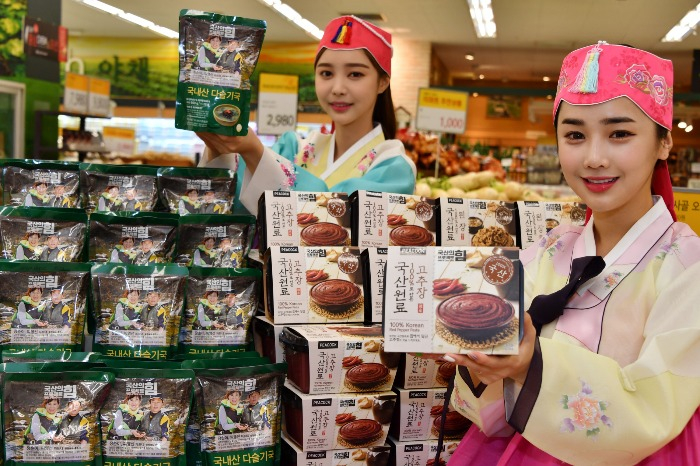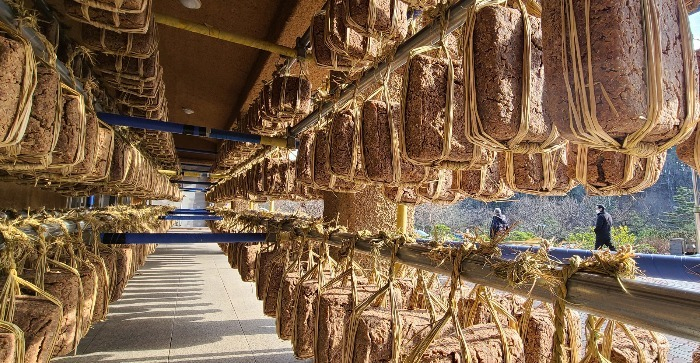-
KOSPI 2812.05 +41.21 +1.49%
-
KOSDAQ 756.23 +6.02 +0.80%
-
KOSPI200 376.54 +6.64 +1.80%
-
USD/KRW 1373 3.00 -0.22%
Gochujang exports increase 35% on-year
F&B
Gochujang exports increase 35% on-year
Exports of Korean fermented pastes like gochujang and doenjang have enjoyed a steady rise over the last four years
By
Jan 24, 2022 (Gmt+09:00)
2
Min read
News+

Exports of Korean fermented pastes like gochujang and doenjang have increased steadily for the past few years, thanks to the rise in popularity of Korean pop culture depicting local food.
Gochujang is a Korean fermented red chili paste that has savory, sweet and spicy flavors. Doenjang, fermented soy bean paste, is another staple in Korean cooking.
In 2020, exports of gochujang recorded $50.9 million, a 35% jump from the previous year. In 2016, gochujang exports stood at $31.3 million, 63% lower than the 2020 figure.
The United States had the biggest appetite for the Korean chili paste, accounting for 26% of all gochujang exports. China and Japan followed; taking up 17% and 10% of the total exports, respectively. Gochujang exports to the Philippines accounted for 6% of the global total.
The joint report came to the conclusion that the perception of gochujang is different from that of other Korean food such as bibimbab.
The research team wrote, “While bibimbab, kimchi and Korean ginseng are considered health foods abroad, gojuchang is considered more ‘hip food content’ that K-pop stars like BTS enjoy and often get featured in OTT.”
An over-the-top (OTT) media service is a media product offered directly to viewers via the internet. AppleTV, Netflix, and content apps created by celebrities that show exclusive content are popular examples.
The report added, “Gochujang is consumed abroad as if a kind of entertainment, much like short-form content such as TikTok.”
Within the US, the biggest importer of gochujang, the Korean condiment has successfully differentiated itself from other hot sauces like Tabasco and Sriracha. Unlike the other spicy condiments, gochujang has a touch of sweetness thanks to the starch from cooked glutinous rice.

Exports of doenjang stood at $11.7 million in 2020, up 29% from the previous year. The latest figure is a 45% jump from 2016.
By region, exports to Southeast Asian countries rose by a big margin.
The joint report concluded that there was increased exposure to Korean food in Singapore and Thailand, on the back of popular TV series such as Itaewon Class. “The popularity of K-drama has led to a growing appetite for Korean food,” the report explained.
Korean fermented cabbage kimchi, for its part, also saw its first trade surplus in 12 years last year. South Korea exported $136.6 million worth of kimchi from January to October 2021, following exports of $144.5 million the previous year.
The increased exports of fermented pastes and kimchi are in line with the rising demand for other packaged food from Korea.
South Korea exported the largest amount of packaged food in 2020 since the country was established in 1948. Excluding livestock, marine products, and beverages, the country exported approximately $4.3 billion worth of packaged food outside the peninsula.
Despite the global pandemic, the 2020 export figure grew by 14.7% from about $3.7 billion in 2019.
Write to Bae Jeong-Cheol at bjc@hankyung.com
Jee Abbey Lee edited this article.
More To Read
-
 Business & PoliticsKorea’s ruling party revives corporate law reform with stricter rules
Business & PoliticsKorea’s ruling party revives corporate law reform with stricter rules15 HOURS AGO
-
 Tech, Media & TelecomLG Display to invest $500 mn to boost smaller OLED output
Tech, Media & TelecomLG Display to invest $500 mn to boost smaller OLED outputJun 05, 2025 (Gmt+09:00)
-
 Shareholder activismProxy voting rises in South Korea, but few vetoes cast
Shareholder activismProxy voting rises in South Korea, but few vetoes castJun 05, 2025 (Gmt+09:00)
-
 Business & PoliticsKorea signs definitive $19 bn Czech nuclear plant deal after twists and turns
Business & PoliticsKorea signs definitive $19 bn Czech nuclear plant deal after twists and turnsJun 05, 2025 (Gmt+09:00)
-
 Food & BeverageCJ Foodville goes global from in-flight meals to Starbucks bread
Food & BeverageCJ Foodville goes global from in-flight meals to Starbucks breadJun 04, 2025 (Gmt+09:00)


